Lifelong Impact of Early Self-Control
By Terrie Moffitt, Richie Poulton, Avshalom Caspi
Childhood self-discipline predicts adult quality of life.
Childhood self-discipline predicts adult quality of life.

DOI: 10.1511/2013.104.352
When we first joined the Dunedin Study team in the 1980s, we had been taught in our psychology Ph.D. training to think in developmental stages: We had learned what is typical of preschoolers, of teenagers, and of older persons. But “typical” failed to describe any of the 1,000 Study participants, who had been physically and psychologically examined since their birth in the early 1970s and were now teenagers.

Illustration by Tom Dunne.
By interviewing these young people, we learned to appreciate the remarkable variation among people of the same age. When asked if he had ever started a fight and tried to hurt someone, one cheeky boy replied, “Only Catholics—do they count?” When asked if he had ever been in trouble with the police, a 13-year-old boy replied, “Not yet ma’am, but no worries, it’s a-coming to me.” Asked to complete a simple drawing task, a girl struggled for six minutes, determined despite severe disabilities. One daring girl snuck out with a stolen game under her sweater. A quiet boy recited multiplication tables for fun. The children ranged remarkably in a quality that we have devoted much of our science to understanding: self-control.
Our 40-year study of 1,000 children revealed that childhood self-control strongly predicts adult success, in people of high or low intelligence, in rich or poor.
The capacity for self-control over our thoughts and actions is a fundamental human faculty. But the inability to make use of that capacity can be our greatest personal failure, especially in today’s fast-paced, fast-food world of endless possibility, distraction, and temptation. It’s no wonder that every self-help literature shelf is cluttered with promises of greater self-discipline.
People are living longer than ever. To avoid disability, dependency, and poverty, people focus on their long-term health and wealth. Managing retirement savings demands incredible foresight at the same time that one is daily bombarded by seductive advertising. Delectable, high-calorie foods are on every corner, even as jobs leave people exercising little besides their fingers and minds. Should it be any surprise that Westerners face an epidemic of obesity?
As more citizens receive more years of education, intellectual achievement alone no longer wins the competition for good jobs; employers now screen graduates (and their Facebook pages) for signs of conscientiousness and perseverance, or the lack thereof. These remarkable historical shifts are enhancing the value of individual self-control, not only for well-being but also for survival.
Our home lives aren’t much simpler. The prevalence of working parents requires a delicate balance of ever-shifting roles and priorities. When times get tough at home, divorce is now a ready and socially acceptable option—as are a wide range of addictive substances, prescription or otherwise. Keeping a family healthy and intact requires a tremendous act of will: Parents teach their children to control themselves and their emotions along with teaching them their ABCs.
Curiosity about the power of self-control skills, which include conscientiousness, self-discipline, and perseverance, arose from recent empirical observations that preschool Head Start, an ambitious, federally funded program of special services launched in 1965 to boost the intellectual development of needy children, has failed to achieve the goal of boosting IQ scores. But the programs have unexpectedly succeeded in lowering the former pupils’ rates of teen pregnancy, school dropout, delinquency, and work absenteeism.
IQ was not increased by Head Start but clearly something else was. A 2006 paper in Science by economist and Nobel laureate James Heckman and others posed the question: Could it be self-control? We recognized on reading it that we were in a unique position to learn answers to this question, using data from the Dunedin children we had followed for the past 40 years. If self-control is a malleable, teachable determinant of success in health, wealth, parenting, and avoiding crime, then policies aiming to enhance it could have broad benefits. Our quest over the past few decades has been to understand whether childhood self-control affects adult life chances, and how powerfully. Evidence may convince policy makers that enhancing self-control can effectively reduce major social problems.
When we decided to look into self-control, we knew we faced skeptics. In fact, we ourselves were skeptical. Many behavioral scientists believed that self-control problems were a normal part of childhood and quickly outgrown. If true, then childhood self-control would have no implications for adult life. Other scientists conceded that self-control may be of mild academic interest, but said it could not be as influential for adult life as a child’s IQ or social class. Some conceded self-control may be influential, but unworthy of study because it is impossible to change. Still others viewed self-control as important, but only in the small group of children diagnosed with severe attention-deficit hyperactivity disorder (ADHD). We knew we might find that self-control bore no relation to adult outcomes, or that its connection to adult life would pale to insignificance once IQ and social class were added to our analyses. We half expected to find poor adult outcomes restricted to ADHD children. To our own surprise, our 40-year study of 1,000 children revealed that childhood self-control strongly predicts adult success, in people of high or low intelligence, in rich or poor, and does so throughout the entire population, with a step change in health, wealth, and social success at every level of self-control.
In the context of intense policy interest in self-control, the longitudinal study that we had been involved with for decades provided invaluable information about variation in self-control and well-being across a population and across each individual’s lifetime. The Dunedin Multidisciplinary Health and Development Study is a 40-year investigation of health and behavior in just over 1,000 individuals born between April 1972 and March 1973 in Dunedin, New Zealand. The study began with babies as an obstetric survey of newborn health but evolved into a powerful long-term study of much more, including behavior and psychology. Assessments of the Study participants were carried out at birth and at ages 3, 5, 7, 9, 11, 13, 15, 18, 21, 26, and 32. Remarkably, between 2011 and 2012, 95 percent of the 1,007 surviving study members, now 38-year-old adults, took part in the most recent assessment. For each assessment, study members return to our research center in Dunedin, as they have done all their lives, for eight hours of grueling tests, examinations, and interviews about a broad array of topics related to their health, wealth, and behavior, including self-control.
The Dunedin Study observes real people living real lives, so this design lends itself to analyzing correlations to understand behavioral patterns over the participants’ lifetimes. Importantly, Dunedin participants with low self-control and poor outcomes have not dropped out of the study, enabling us to explore a full range of life experiences. Because of the study’s design, we can address multiple policy-relevant questions: whether self-control measured at preschool age can predict outcomes in adulthood; whether children with low self-control are more likely as teenagers to smoke tobacco, drop out of school, or become teen parents; whether children’s self-control consistently predicts their later health, wealth, criminality, and parenting; and what any of it has to do with happiness.
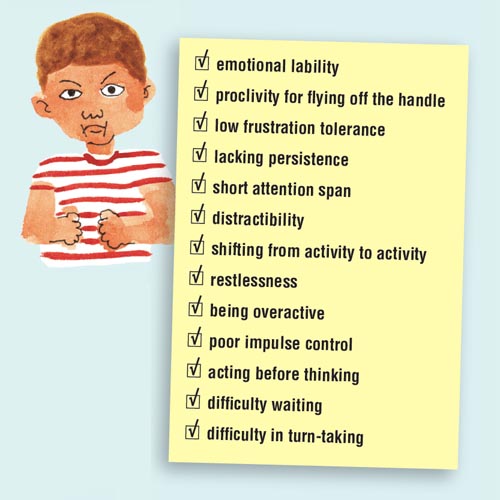
Illustration by Tom Dunne.
We assessed the Dunedin children’s self-control during their first decade of life. Each child’s self-control was ascertained in multiple ways: across ages 3, 5, 7, 9, and 11, our research staff made observational ratings of each child’s behavior at the research center, teachers filled in questionnaires sent through the mail, parents were interviewed, and at older ages the children themselves were interviewed. Because these many ratings were strongly correlated, we combined them into a single, highly reliable composite self-control measure (click + sign above to see caption “What Is Self-Control?”). All children lack self-control now and then, but this composite measure ensured that low scorers had shown poor self-control in a variety of situations and across years. Mean levels of self-control were significantly higher among girls than among boys, but the implications of childhood self-control were equally evident for both sexes. We therefore combined the sexes in all subsequent analyses (but controlled statistically for the effects of sex, just to be sure).
It is well known that high family social class and good intelligence influence children’s adult life success. We see this pattern in our study as well: Dunedin children with greater self-control are significantly more likely to be from socioeconomically advantaged families. Children with greater self-control also had significantly higher IQs when tested by the Study in the 1970s. These findings raised the question of whether self-control has any effects of its own on a child’s development. We therefore introduced statistical controls to all analyses described here, to test whether childhood self-control predicted adults’ health, wealth, parenting style, and likelihood of committing crime, independent of their social class origins and IQ.
In our research into the effect of self-control, one of our key goals was to examine adult health problems because these are known early warning signs for costly age-related diseases and premature mortality. To do this, we conducted a thorough assessment of the Dunedin children when they reached their thirties. Each participant underwent a series of physical examinations and laboratory tests to assess obesity, hypertension, and lung damage; we even had them checked for periodontal disease. We also tested blood samples for high cholesterol, sexually transmitted infections, and blood proteins indicating systemic inflammation.
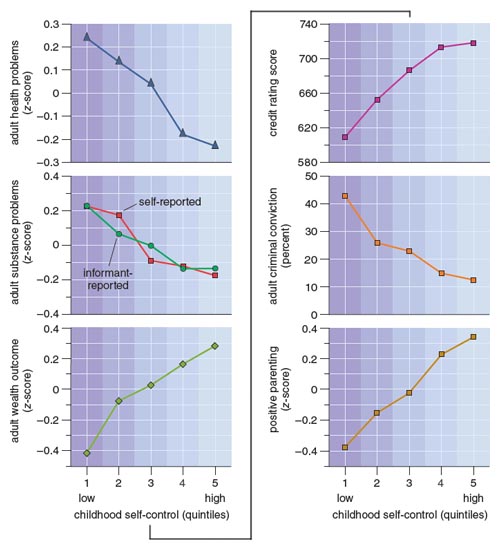
Graphs adapted by Tom Dunne from Moffitt, T. E., et al. Proceedings of the National Academy of Sciences of the U.S.A. doi:10.1073/pnas.1010076108.
We summed these clinical measures into a simple physical health index for each Study member. Although 43 percent had none of the clinical biomarkers, 20 percent had two or more biomarkers. Childhood self-control significantly predicted the number of these adult health problems (See the top left graph above). We also conducted clinical interviews with the Study members in their thirties to assess substance dependence. As adults, children who had shown poor self-control reported significantly elevated risk of substance dependence, and were addicted to a greater number of substances. Because people may underreport their substance abuse, we also turned to independent informants for confirmation. Each participant nominated someone who knew him or her well and could complete a survey about his or her life situation. The informants verified this longitudinal link between self-control and substance dependence: As adults, children with poor self-control were more likely to be rated by informants as having alcohol and drug problems.
In addition to health problems, we examined unfavorable outcomes in wealth, such as low income, poor saving habits, credit problems, and social welfare dependence—all early warning signs for late-life poverty. Once again, childhood self-control foreshadowed the Study members’ situations in their thirties. People who as children exhibited poor self-control were by their thirties less likely to have saved money and had acquired fewer financial building blocks for the future (such as home ownership, investment funds, or retirement plans). Children with poor self-control also were more likely to struggle financially in adulthood: They reported to us more money management difficulties and credit problems. This link between self-control and self-reported financial problems was again verified by informants who knew them well.
Official administrative records also confirmed that childhood self-control predicts adult financial outcomes. For example, self-control ratings in childhood foretold our Study members’ official credit ratings in adulthood, ratings that can impede attainment of business loans or home mortgages. A match of Study members to the VEDA Credit System for Australia and New Zealand revealed that the lowest self-control children were most likely to be rated as undesirable credit risks as adults.
With the assistance of the New Zealand Ministry of Social Development, we further examined costs to government in the form of social welfare benefit dependence, by matching Study members to records of monthly social welfare payments. More than half the cohort had at some time received such benefit payments. Although most voters want their country to have a safety net, few approve of long-term dependence on social welfare benefits. Self-control ratings only weakly predicted which members of the Dunedin group had received a government benefit, indicating that a broad range of people need help, particularly in today’s weak economy. However, if they did receive a benefit, those Study members with the poorest self-control were likely to stay on benefits for a longer period of time. Benefit recipients in the cohort’s highest quintile of childhood self-control had used benefits on average for less than 18 months, whereas recipients in the lowest self-control quintile had used benefits on average for more than six years. Overall, children who had lower self-control grew up to be adults with more financial difficulties.
We also examined convictions for crime, because crime control poses major costs to government. For example, crime prevention, control, criminal courts, and incarceration have been estimated to account for 10 percent of the U.S. gross domestic product, almost as much as health care. We obtained records of Study members’ court convictions at all courts in New Zealand and Australia by searching the central computer systems of the New Zealand police; one quarter of the Study members had been convicted of a crime by their thirties (comparable to conviction rates in other developed nations). Children with poor self-control were more likely to have been convicted of a criminal offense. Among the 5 percent of the cohort who had spent time incarcerated, more than 80 percent came from the cohort’s two lowest quintiles of childhood self-control.
The Dunedin Study let us examine the effects of self-control on not only the Study participants but also their children. The first Dunedin Study member became a parent in 1988 at age 15, and by 2012, three quarters of the 1,037 members were parents. When the first child of each member reaches age 3, our research team visits the family at home to record parent–child interaction during a standardized set of activities. Family psychologists blind to all other information about the Study rate videos on aspects of parenting, including affection and sensitivity to their child’s needs. On an overall combined rating of parenting quality, Study members who as children had poor self-control grew up to be the least skilled parents of their own children. Childhood self-control also strongly predicted whether these members’ offspring were in a two-parent or a one-parent household. One-parent households were more likely for adults that had low self-control as children. These findings imply that one generation’s low self-control causes disadvantages to the next generation.
In summary, boys and girls with weaker self-control had worse health, less wealth, less skilled parenting, and more crime as adults than those with stronger self-control, and that pattern held at every point along the gradient of self-control. To check that our observed correlation was robust, we repeated the analyses after removing children in the least and most self-controlled quintiles. We continued to observe significant linear associations, indicating that the findings did not depend on an extreme group.
Psychiatrists asked us if the societal challenge of self-control could be ameliorated simply by treating childhood ADHD. To investigate, we removed the 61 members who were diagnosed with ADHD and repeated the analyses. The gradient associations remained unaltered. These results, coupled with the persistent effects of self-control after accounting for variation in sex, social class origins, and IQ, suggest that teaching self-control skills, if they can be taught, would benefit even children who score above average on self control, are intelligent, or come from affluent homes.
The strength of our observed correlations between childhood self-control and adult quality of life made us wonder when and how that correlation emerges. Our composite measure of self-control in the Dunedin Study included assessments from multiple reporters, covering ages 3 to 11. To answer our question, we isolated our research staff ratings of self-control made when the children were 3–5 years old in the mid-1970s. This measure is a weaker one because in those early years we had only a stranger’s observations from a 90-minute meeting with the child at our research center. Nevertheless, that brief observation of preschoolers’ self-control significantly predicted outcomes in the fourth decade of life, although less well than our more extensive measure that included parent and teacher opinions collected over the years from ages 3 to 11.
Early warning signs of troubled adulthood often arise in adolescence, but we were not sure if interventions addressing self-control at this life stage would be effective in preventing undesirable life outcomes. Data collected at ages 13, 15, 18, and 21 showed that children with poor self-control were more likely to make mistakes as adolescents. For example, more children with low self-control began smoking by age 15, left secondary school early with no educational qualifications, and became unplanned teenaged parents. The lower their self-control as children, the more ensnared they were as teens; and the more snares they encountered, the more likely they were to have poor health, less wealth, unskilled parenting, and a criminal conviction record 20 years later.
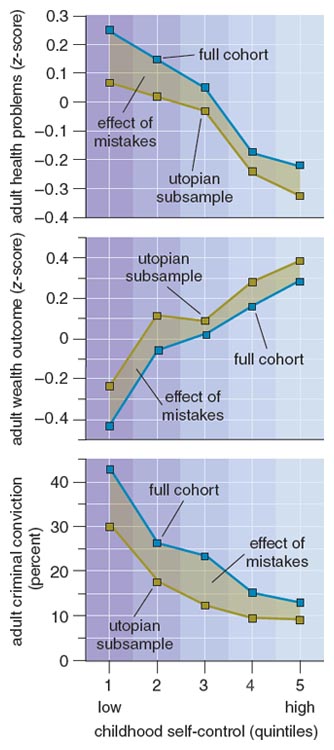
Graphs adapted by Tom Dunne from Moffitt, T. E., et al. Proceedings of the National Academy of Sciences of the U.S.A. doi:10.1073/pnas.1010076108.
We also tested the association between childhood self-control and the adult outcomes among adolescents who encountered no snares, a so-called utopian group of nonsmoking, non–teen-parent, secondary-school graduates. Compared with the full cohort, this utopian subset had better health, wealth, and crime history, illustrating that preventing adolescent mistakes can enhance adult outcomes for children at any level of self-control. This comparison of adult outcomes for teens who did versus did not make mistakes hints at what successful intervention might accomplish. However, prediction from childhood self-control to the adult measures remained significant along a gradient, even among the utopian group. Helping teens avoid snares could improve population health, wealth, child welfare, and public safety somewhat, but building self-control skills before the teen years is also warranted.
Policy making requires evidence that isolates self-control as an active ingredient in health, wealth, and crime, beyond intelligence or social class origins. In the Dunedin Study, statistical controls consistently reveal that self-control has an independent effect on life outcomes. However, each Study member grew up in a different family, and their families varied in many other ways that influence children’s life outcomes, making it tricky to know whether self-control was more important than unmeasured variables.
For an acid test of self-control as an active ingredient, we took advantage of an independent study, the Environmental-Risk Longitudinal Twin Study (E-risk), a British birth cohort of 2,232 twin siblings whom we have tracked since their birth between 1994 and 1995, with 96 percent retention. We designed the E-risk Study to replicate the Dunedin Study, this time with the advantage of two children per family.
Twins do not have identical levels of self-control, but they do grow up in the same family, which gave us the opportunity to ask whether the sibling in each twin pair who had lower self-control later developed worse outcomes. This compelling quasi-experimental research design isolates the influence of self-control by tracking and comparing siblings, disentangling the individual child’s self-control from all other features on which families differ. We analyzed self-control differences within 509 same-sex fraternal twin pairs, because, unlike identical twins, fraternal twins are no more alike as children than ordinary siblings on their self-control levels.
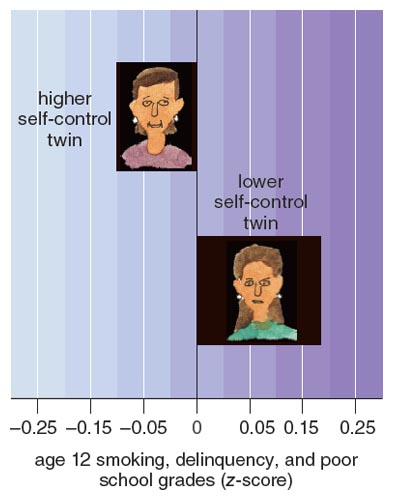
Graph adapted by Tom Dunne from Moffitt, T. E., et al. Proceedings of the National Academy of Sciences of the U.S.A. doi:10.1073/pnas.1010076108.
When the E-Risk twins were five years old, our research staff rated each child on the same measure of self-control we had used when the Dunedin children were preschoolers. Although the E-risk children had been followed up only to age 12 when we performed analyses for this article, their age-5 self-control already forecasted many of the outcomes we saw in the Dunedin Study. Our analysis showed that the 5-year-old sibling with poorer self-control was significantly more likely as a 12-year-old to begin smoking (a precursor of poor adult health), perform poorly in school (a precursor of adult poverty), and engage in antisocial conduct problems such as stealing and fighting (a precursor of adult crime). (See the chart above.)
Another provocative finding from the E-Risk study attests to the societal cost of low self-control. The twin with lower self-control was rated by teachers as requiring more of their effort in the classroom. Results showed that children with low self-control deplete teachers’ energy for teaching other pupils. Children lacking in self-control may even contribute to teachers’ job dissatisfaction and attrition.
Our results from the Dunedin Study show that individual differences in childhood self-control have key social effects. They predict multiple indicators of health, wealth, parenting, and crime across three decades of life, in both sexes. Furthermore, the E-risk Study comparison of fraternal twins helped us disentangle the effects of children’s self-control from the effects of variation in their social class and home lives, singling out self-control as a clear target for intervention policy.
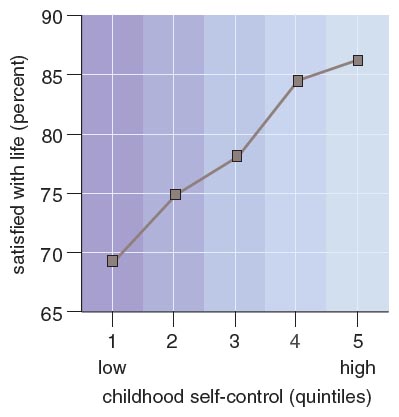
Graph adapted by Tom Dunne from Moffitt, T. E., et al. Proceedings of the National Academy of Sciences of the U.S.A. doi:10.1073/pnas.1010076108.
But are children with self-control happy? Some may express concern that children with the highest levels of self-control must be rigid, unspontaneous, and unhappy. They fear that interventions may reduce happiness. Prompted by this concern, we examined indicators of our Study members’ life satisfaction in the fourth decade of life. Fortunately, most cohort members said they were satisfied with their lives: 70 percent were somewhat or very satisfied. However, the most satisfied of all were those who began life with high self-control (nearly 90 percent of them felt satisfied). High self-control protected Dunedin Study members from suicide, an objective indicator of deep unhappiness. Of participants in the bottom fifth of self-control scorers, 22 percent attempted or died by suicide by age 38, but only 7 percent in the top fifth of childhood self-control scorers made a suicide attempt.
Joining earlier longitudinal follow-up studies, our findings imply that innovative policies that put self-control center stage could reduce a panoply of costs that now heavily burden taxpayers and governments: health care delivery, crime control, social welfare, and education. Moreover, many Dunedin Study members with low self-control had unplanned babies who are now growing up in a low-income single-parent household lacking in skilled parenting, where the parent is substance-dependent, in poor health, or overcoming a criminal record. Therefore, one of the highest costs of self-control may be the poor start it creates for successive generations.
Improving childhood self-control is especially appealing because we find that differences in self-control between children predict their adult outcomes approximately as well as (sometimes better than) low intelligence and low social class origins, factors known to be extremely difficult to improve through intervention. Effects were marked at the extremes of the self-control gradient. For example, by adulthood those with the highest and lowest childhood self-control were at opposite ends of the spectrum in adult outcomes. For Study participants in the top fifth of childhood self-control scores, only 10 percent made an annual income below the poverty line, as opposed to the 32 percent of adults who as children had scored in the bottom fifth on self-control measures. Similarly, the top fifth exhibited crime-conviction rates of 13 percent as opposed to 43 percent for the bottom fifth.
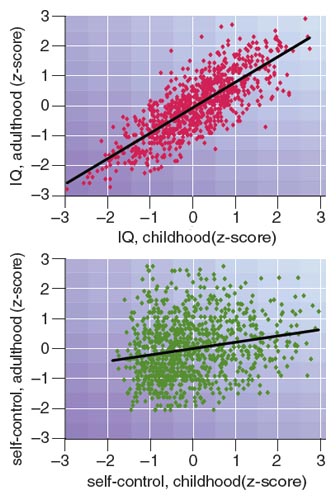
Graphs adapted by Tom Dunne from Moffitt, T. E., et al. Proceedings of the National Academy of Sciences of the U.S.A. doi:10.1073/pnas.1010076108.
After establishing the strong relationship between childhood self-control and adult well-being, we still were not sure what, if anything, could be done to help those with weak self-control. Many potential interventions seemed promising, so we began to look into their effectiveness. Possible interventions run the age gamut, targeting preschool children to adults, and interventions approach the self-control deficit at many levels, from one-on-one skill training to federal legislation. Importantly, analyses led by Brent Roberts of the University of Illinois attest that self-control can change. In fact, in the Dunedin Study, across the first four decades of life, study members’ self-control scores were only about half as stable as their IQ test scores (See the graphs above). We found one factor that improved some members’ self-control rank: working as a supervisor responsible for subordinate employees. Of course, those who became managers already had good self-control, one likely reason that they were hired or promoted. However, even after becoming bosses, their self-control scores rose rapidly compared with scores of their cohort peers.

http://sesamestreet.org/parents/topicsandactivities/toolkits/save; photograph courtesy of Richard Termine.
In our studies, health, wealth, and crime outcomes followed a gradient across the full distribution of self-control in the population. The observed gradient implies that better outcomes are possible and suggests universal interventions. Such programs benefit everyone, avoid stigmatizing anyone, and therefore attract widespread citizen support. An example of a universal intervention is Sesame Street’s multimedia activity “For me, For you, For later,” which teaches preschoolers to delay gratification by saving money toward a goal.
Programs to enhance young children’s self-control have been developed, and many show promise. Such self-control enhancers for children include martial arts, music lessons, and computer games. Even mastering a second language develops self-control. There are programs for school classrooms, based on the notion of “plan, do, then review.” Some programs target parents, coaching them on how to raise their child’s self-control quotient. The challenge remains to improve these programs and scale them up for universal dissemination with a good cost-benefit ratio. Many programs show potential as small model demonstrations delivered to keen volunteer families by enthusiastic experts. But these promising schemes must work just as well when transferred to a statewide school system and implemented by nonprofessional staff. Randomized trials should show that the programs produce real change in self-control skills, and long-term follow-ups need to show that the change is lasting. Economic analyses must weigh whether the up-front costs of each program are outweighed by their eventual effect on costs of health care, crime, and financial dependency.
Our findings support a “one-two punch” strategy of scheduling interventions during both early childhood and adolescence. On the one hand, the connection between low self-control and poor outcomes from childhood to adulthood was in part a function of mistakes made in adolescence. Therefore, interventions that prevent teenagers’ mistakes may improve health, wealth, child welfare, and public safety for the population. On the other hand, because childhood self-control predicts which teens will make life-altering mistakes, early-childhood intervention could prevent teens from making such mistakes in the first place. Even among teens who managed to finish high school as nonsmokers and nonparents, the level of personal self-control they had achieved as children explained substantial variation in their health, finances, and crime rates when they reached their thirties. Consequently, enhancing self-control in early childhood will likely bring a greater return on investment than waiting until adolescence.
Even in adulthood, there may be meaningful ways to improve self-control. Social psychologists have marshaled experimental evidence that self-control is like a muscle: Adults can exercise and strengthen it, but their self-control can also be depleted when they are stressed, intoxicated, or fatigued. In a culture in which low self-control reigns, policy makers have tended to respond with schemes that make socially responsible behaviors, such as eating healthfully, saving money, or obeying the law, the effort-free default option. For example, the crime-reduction policy called “target hardening” discourages would-be offenders by making law-breaking so onerous that it loses its easy-money appeal (A case in point is sophisticated antitheft devices in today’s cars demand more advance preparation and diligence of would-be car thieves). Similarly, because a default automatic payroll-deduction retirement savings scheme requires no effort, more employees save successfully without trying. Such plans assume that just a nudge can compensate for imperfect self-control.
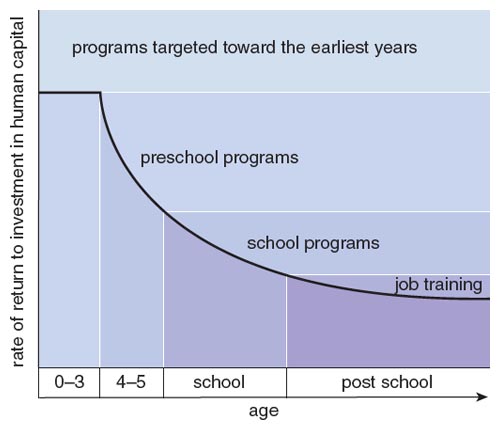
Figure adapted by Tom Dunne from Heckman, J. Science 312:1900.
Our research demonstrates that the segment of the adult population most inclined to avoid effortful planning is the same segment of the adult population that accounts for the most costs to society. So-called nudge policies intended to exploit the laziness in all of us should work best for the least self-controlled among us, significantly magnifying their benefits. Ultimately, when all hope is lost that adults will control themselves in response to a nudge, nations resort to passing coercive laws to enforce self-control, such as banning smoking in public places and making motorcycle helmets, seatbelts, and infant car seats obligatory.
Both the Dunedin and E-risk studies are long-term research projects that will continue to improve our understanding of self-control. The study members continue to grow up and grow older, and, we hope, accept our invitations to take part in each burdensome, intrusive new wave of data collection.
The segment of the adult population most inclined to avoid effortful planning is the same segment that accounts for the most costs to society.
In longitudinal research like this, we scientists design measurements to record the most important biological and social developments at each stage of life. When the participants were babies, our team had to be expert on questions of birth weight, breastfeeding, infant sleep, and language development. Now, we are launching investigations into infertility, retirement savings, parenting, and telomere erosion. At the same time, we assess certain parameters of health and mental ability, as well as self-control, at every age to maintain continuity.
The interplay of genes and environment is a particularly rich new theme of our research. Until now, neuroimaging has been conspicuously missing from the Dunedin Study’s treasure trove of measurements. We are preparing to study variation in the structure of Study members’ brains, as well as direct fMRI studies of how their brains process threat, reward, memories, and the executive functions of self-control. Our U.S.–New Zealand–U.K. team is already planning investigations of members’ experiences of menopause, memory loss, grandparenting, and eventually retirement. The Study members’ great gift to science is their lifelong collaboration in this work.
Globally, the human population is trending toward fewer children and more elderly people. If this trend continues as predicted, soon young workers will be obliged to support a larger number of retired seniors. In the coming century the value that society places on every child will increase, along with expectations that each must contribute maximally toward his or her nation’s health, wealth, and public safety. Simultaneously, the trend toward longer life expectancy means that today’s children must prepare strategically while still young to secure well-being in their own protracted old age. These historic demographic changes are driving up the value of individual self-control. The two cohorts we are studying—born in different countries and different decades—strongly support that improving individual self-control will prove essential for humanity’s long-term health, wealth, safety, and happiness.
Click "American Scientist" to access home page
American Scientist Comments and Discussion
To discuss our articles or comment on them, please share them and tag American Scientist on social media platforms. Here are links to our profiles on Twitter, Facebook, and LinkedIn.
If we re-share your post, we will moderate comments/discussion following our comments policy.